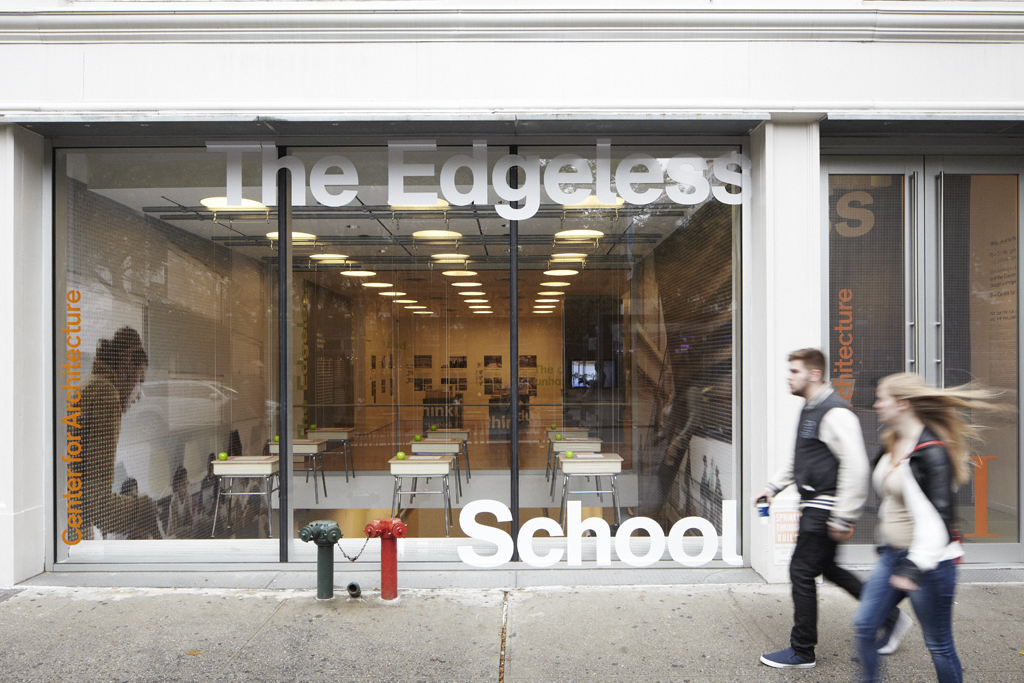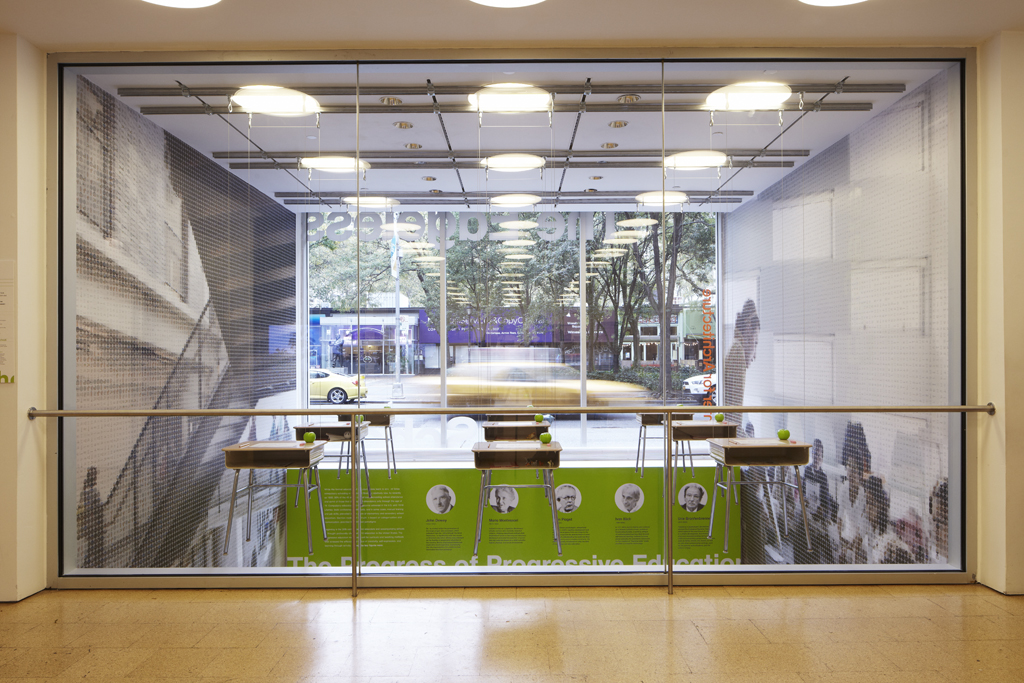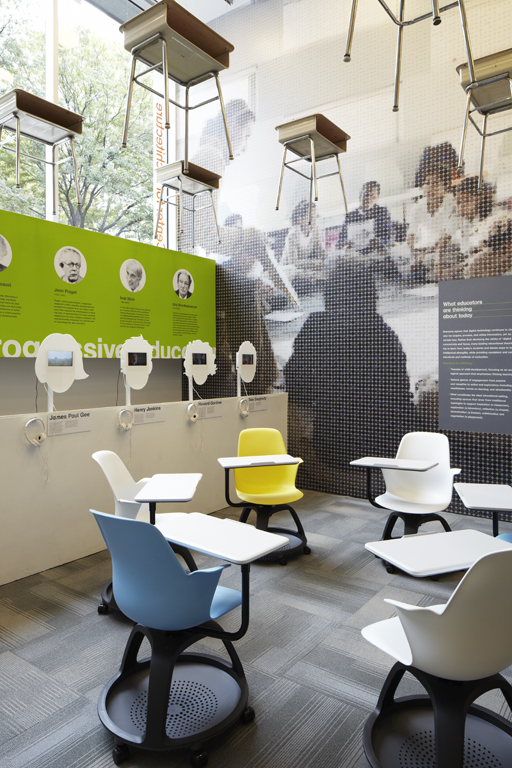by Bill Millard
Organizers, “The Edgeless School: Design for Learning”: AIANY in collaboration with the Committee on Architecture for Education and the Center for Architecture Foundation
Senior Research Consultant: Edith Ackermann, Ph.D., Visiting Scientist, MIT School of Architecture
Exhibition Design: Sage and Coombe Architects
Graphic Design: Hyperakt
Organizers, “The Best School in the World: Seven Finnish Examples from the 21st Century”: Museum of Finnish Architecture, as part of New Finnish Design CITY campaign, produced by the Consulate General of Finland and the Finnish Cultural Institute in New York
Eerily suspended rows of traditional school desks, aligned identically and equipped with sheets of ruled paper and uniformly positioned apples, are currently drawing the eyes of curious passers-by into the Center for Architecture’s Hines Gallery. The effect is both familiar and uncanny. Perhaps everyone’s recollections of grammar school, fond or otherwise, share certain qualities with dreams.
The new “The Edgeless School” exhibition, once one’s gaze moves past the disembodied desks and orderly geometries of yesteryear, offers variations on themes of fluidity, blurred borders, shifting roles for teachers and students, and altered relations between schooling and extracurricular life: forms and practices that the schools of the not-too-distant past were unprepared for.
Displays representing 19 architecturally distinguished K-12 schools nationwide (including urban, suburban, and rural settings; a mix of public, private, and special-needs institutions; and scales from the tight Manhattan sites of the East Harlem, Stephen Gaynor, and Rodeph Sholom schools to spacious campuses like Blue Valley Southwest High in Overland Park, KS) show how built forms express evolving teaching philosophies. These American examples share some features with the seven schools in a companion exhibition from Finland, where progressive design and policy have converged to yield impressive gains in student performance.
Schools’ built environments – like contemporary pedagogy itself – commented curator Thomas Mellins at the press preview, are abandoning the artificiality reflected in the Cartesian grid of airborne desks. “Everyone seems to agree that we’re at a watershed moment in terms of formal education in this country,” he said, noting that educating “digital natives,” students who have spent their whole lives in an information-rich environment, creates new expectations. If information and knowledge are now universally accessible, are traditional schools dinosaurs? Does introducing young people to the life of the mind require dedicated rooms or buildings at all? (One recalls President James Garfield’s legendary definition of the ideal college as [Williams president] “Mark Hopkins on one end of a log and a student on the other.”)
These questions aren’t easily answerable. Hence ”The Edgeless School” model, offering gray areas rather than sharp conceptual and physical demarcations between teachers’ roles as wise elders dispensing information or facilitators of students’ discoveries; separate and merged interior areas; purpose-built and ad hoc spaces; built environments and nature; town and gown; and the most basic borderline: formal schooling vs. informal, extramural, experiential processes of education. Parental expectations, adds Mellins, have evolved, and school design needs to consider them: “In the early 20th century, parents were very often expecting the schools to Americanize their children” and looked to school authorities for that role, while today’s parents, connected through constant electronic communication, not just annual parent-teacher conferences, are more directly involved and hold teachers “accountable to them,” altering the metaphoric meaning of transparency.
Despite all too many schools’ depressing atmosphere of carceral chain-link fencing, the best ones are organized for flexibility and surprise, not warehousing and discipline. Mellins described a “discovery that corporate America made quite some time ago: very often the best ideas don’t come out of the conference room or the board room, but… out of the chance encounters that happen at the water cooler.” The educational equivalent is to design for social interaction and collaboration, emphasizing open areas, multipurpose spaces (e.g., “a science lab that’s also an art room”), and scales appropriate to students’ needs. Children with autistic-spectrum conditions, for example, benefit from alcoves small enough for two or three kids and a teacher, plus extensive glazing to help them observe and mirror other kids’ interactions.
Mellins and colleagues look to a series of pathbreakers in progressive education for theoretical grounding, including John Dewey, Maria Montessori, Jean Piaget, Ivan Illich, Howard Gardner, John Seely Brown, and others whose ideas are presented in interior displays, among more up-to-date furniture: a Smart Board and an array of Steelcase rolling desk/chair/storage modules, which Mellins described as ideal for classrooms where teachers circulate freely, rearrange the students’ positions, and strive to keep floors uncluttered by ubiquitous backpacks. Such spaces support engagement with students’ diverse forms of intelligence and fit teachers’ evolving role: once the “Sage on the Stage,” now more often the “Guide on the Side.”
If media reports too often associate American schools with funding shortages, program cutbacks, declining scores, “teach to the test” narrowness, and metal detectors, what helps some schools perform better? Handsome facilities alone don’t create an atmosphere of professional dedication and imagination, but they can aid educators in developing one. Finland’s school system has earned global admiration among teachers and designers, as Finnish students recurrently earn high scores in the Organisation for Economic Co-operation and Development’s Programme for International Student Assessment (PISA) surveys, across the range of academic subjects and family socioeconomic backgrounds.
The Museum of Finnish Architecture’s Juulia Kauste answers recurrent questions about the key to this success in terms of Finland’s egalitarianism, providing free state-funded education to all as a national principle, as well as its lively tradition of architecture competitions (five of the seven schools shown here resulted from open competitions) and its dedication to upgrading learning environments, diversifying open communal spaces to help schools’ various age groups socialize safely or work privately without constant supervision. Local authorities, she reports, run 97% of the nation’s schools, which observe a national curriculum allowing for local variations. National guidelines consider building features as well as curricula.
“There’s a strong emphasis on this idea that everyone deserves to have the equal right to equal quality of education,” Kauste said, adding that schools provide healthcare and other services, with attention to nutrition and recreation as well as classroom work (the typical Finnish school day includes hourly recesses, she noted, aiding students’ alertness). The double-boomerang volumes by the young firm Verstas Architects for the Kirkkojärvi School in Espoo – perhaps the most striking of the seven sample schools – are both graceful and purposeful: each separate yard, as demarcated by the building’s wings, accommodates a different age group. Since communities also use the facilities after hours, Kauste added, “the school is the center of the community in other ways as well, not only for the students but for other activities,” defining “sustainability not only in terms of green and energy, but [as] cultural sustainability.” These schools treat their indoor and outdoor spaces not as neutral containers, but as environments designed to foster the development of the whole student and the whole community.
“The Edgeless School: Design for Learning” and “The Best School in the World: Seven Finnish Examples from the 21st Century” are on view through January 2013.
Bill Millard is a freelance writer and editor whose work has appeared in Oculus, Icon, Content, The Architect’s Newspaper, and other publications.








